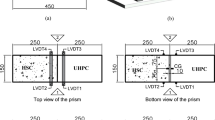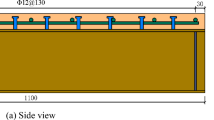Abstract
To study the flexural behavior of prestressed concrete beams with high-strength steel reinforcement and high-strength concrete and improve the crack width calculation method for flexural components with such reinforcement and concrete, 12 specimens were tested under static loading. The failure modes, flexural strength, ductility, and crack width of the specimens were analyzed. The results show that the failure mode of the test beams was similar to that of the beams with normal reinforced concrete. A brittle failure did not occur in the specimens. To further understand the working mechanism, the results of other experimental studies were collected and discussed. The results show that the normalized reinforcement ratio has a greater effect on the ductility than the concrete strength. The cracking- and peak-moment formulas in the code for the design of concrete (GB 50010-2010) applied to the beams were both found to be acceptable. However, the calculation results of the maximum crack width following GB 50010-2010 and EN 1992-1-1:2004 were considerably conservative. In the context of GB 50010-2010, a revised formula for the crack width is proposed with modifications to two major factors: the average crack spacing and an amplification coefficient of the maximum crack width to the average spacing. The mean value of the ratio of the maximum crack width among the 12 test results and the relative calculation results from the revised formula is 1.017, which is better than the calculation result from GB 50010-2010. Therefore, the new formula calculates the crack width more accurately in high-strength concrete and high-strength steel reinforcement members. Finally, finite element models were established using ADINA software and validated based on the test results. This study provides an important reference for the development of high-strength concrete and high-strength steel reinforcement structures.
Similar content being viewed by others
References
American Concrete Institute. Building Code Requirements for Structural Concrete (ACI 318-14). Farmington Hills, MI: American Concrete Institute, 2011
Eurocode 2. Design of Concrete Structures: Part 1–1: General Rules and Rules for Buildings (BS EN 1992-1-1:2004). London: British Standards Institution, 2004
Zealand S N. Concrete Structures Standard, Part 1: The Design of Concrete Structures (NZS 3101). Wellington: New Zealand Standards Council, 2006
China Ministry of Construction. Code for Design of Concrete Structures (GB50010-2010). Beijing: China Architecture and Building Press, 2010
Zeyad A M, Tayeh B A, Yusuf M O. Strength and transport characteristics of volcanic pumice powder based high strength concrete. Construction & Building Materials, 2019, 216: 314–324
Van Deventer J S J, Provis J L, Duxson P. Technical and commercial progress in the adoption of geopolymer cement. Minerals Engineering, 2012, 29(3): 89–104
Gan V J L, Cheng J C P, Lo I M C, Chan C M. Developing a CO2-e accounting method for quantification and analysis of embodied carbon in high-rise buildings. Journal of Cleaner Production, 2017, 141: 825–836
Aïtcin P C. The durability characteristics of high performance concrete: A review. Cement and Concrete Composites, 2003, 25(4–5): 409–420
Pecce M, Fabbrocino G. Plastic rotation capacity of beams in normal and high-performance concrete. ACI Structural Journal, 1999, 96(2): 290–296
Lin C H, Lee F S. Ductility of high-performance concrete beams with high-strength lateral reinforcement. Structural Journal, 2001, 98(4): 600–608
Debernardi P G, Taliano M. On evaluation of rotation capacity for reinforced concrete beams. ACI Structural Journal, 2002, 99(3): 360–368
Chowdhury S H. Cracking and deflection behavior of partially prestressed high strength concrete beams. In: Australasian Structural Engineering Conference 2008: Engaging with Structural Engineering. Melbourne: Meeting Planners, 2008
Swamy R N, Anand K L. Structural behavior of high strength concrete beams. Building Science, 1974, 9(2): 131–141
Ashour S A. Effect of compressive strength and tensile reinforcement ratio on flexural behavior of high-strength concrete beams. Engineering Structures, 2000, 22(5): 413–423
Pam H J, Kwan A K H, Islam M S. Flexural strength and ductility of reinforced normal-and high strength concrete beams. Proceedings of the Institution of Civil Engineers. Structures and Buildings, 2001, 146(4): 381–389
Kaminska M E. High-strength concrete and steel interaction in RC members. Cement and Concrete Composites, 2002, 24(2): 281–295
Lopes S M R, Bernardo L F A. Plastic rotation capacity of high-strength concrete beams. Materials and Structures, 2003, 36(1): 22–31
Reza Ghasemi M, Shishegaran A. Role of slanted reinforcement on bending capacity SS beams. Vibroengineering Procedia, 2017, 11: 195–199
Shishegaran A, Reza Ghasemi M. Performance of a novel bent-up bars system not interacting with concrete. Frontiers of Structural and Civil Engineering, 2019, 13(6): 1301–1315
Rabczuk T, Eibl J. Numerical analysis of prestressed concrete beams using a coupled element free Galerkin/finite element approach. International Journal of Solids and Structures, 2004, 41(3–4): 1061–1080
Rabczuk T, Zi G. Numerical Fracture analysis of prestressed concrete beams. International Journal of Concrete Structures and Materials, 2008, 2(2): 153–160
Rabczuk T, Zi G, Bordas S, Nguyen-Xuan H. A geometrically nonlinear three-dimensional cohesive crack method for reinforced concrete structures. Engineering Fracture Mechanics, 2008, 75(16): 4740–4758
Rabczuk T, Zi G, Bordas S, Nguyen-Xuan H. A simple and robust three-dimensional cracking-particle method without enrichment. Computer Methods in Applied Mechanics and Engineering, 2010, 199(37–40): 2437–2455
Mohammadhassani M, Jumaat M Z, Jameel M. Experimental investigation to compare the modulus of rupture in high strength self compacting concrete deep beams and high strength concrete normal beams. Construction & Building Materials, 2012, 30: 265–273
Li Z H, Su X Z. Analysis of crack patterns of 500 MPa reinforced concrete beams. Advanced Materials Research, 2013, 790: 120–124
Gao R P, Qiu H X, Hu T, Ding Z, Lan Z. Experimental research on crack width of HRB500 steel bars RC beams. Industrial Construction, 2010, 40(3): 66–70 (in Chinese)
Jin W L, Lu C H, Wang H L, Yan R D. Experiment and calculation of crack width of reinforced concrete beams with 500 MPa steel bars. China Civil Engineering Journal, 2011, 44(3): 16–23 (in Chinese)
Xu F B. Experimental and theoretical research on flexural behavior of reinforced concrete beams with HRB500 bars. Dissertation for the Doctoral Degree. Changsha: Hunan University, 2007 (in Chinese)
Padmarajaiah S K, Ramaswamy A. Crack-width prediction for high-strength concrete fully and partially prestressed beam specimens containing steel fibers. ACI Structural Journal, 2001, 98(6): 852–861
Padmarajaiah S K, Ramaswamy A. Flexural strength predictions of steel fiber reinforced high-strength concrete in fully/partially prestressed beam specimens. Cement and Concrete Composites, 2004, 26(4): 275–290
China Ministry of Construction. Standard for Test Method of Mechanical Properties on Ordinary Concrete (GB/T50081-2002). Beijing: China Architecture & Building Press, 2003
General Administration of Quality Supervision. Inspection and Quarantine of the People’s Republic of China. Metallic Materials-Tensile Testing—Part 1: Method of Test at Room Temperature (GB/T228.1-2010). Beijing: Standards Press of China, 2010
Guo Z H, Shi X D. Theory and Analysis of Reinforced Concrete. Beijing: Tsinghua University Press, 2003, 163–337 (in Chinese)
Hussien O F, Elafandy T H K, Abdelrahman A A, Abdel Baky S A, Nasr E A. Behavior of bonded and unbonded prestressed normal and high strength concrete beams. HBRC Journal, 2012, 8(3): 239–251
Acknowledgements
The research in this paper was financially supported by the National Natural Science Foundation of China (Grant Nos. 51878233 and 51778201) and the Anhui Key Laboratory of Civil Engineering and Materials (No. PA2019GDPK0034). This support is gratefully acknowledged.
Author information
Authors and Affiliations
Corresponding author
Rights and permissions
About this article
Cite this article
Jiang, Q., Wang, H., Chong, X. et al. Flexural behavior of high-strength, steel-reinforced, and prestressed concrete beams. Front. Struct. Civ. Eng. 15, 227–243 (2021). https://doi.org/10.1007/s11709-020-0687-3
Received:
Accepted:
Published:
Issue Date:
DOI: https://doi.org/10.1007/s11709-020-0687-3




